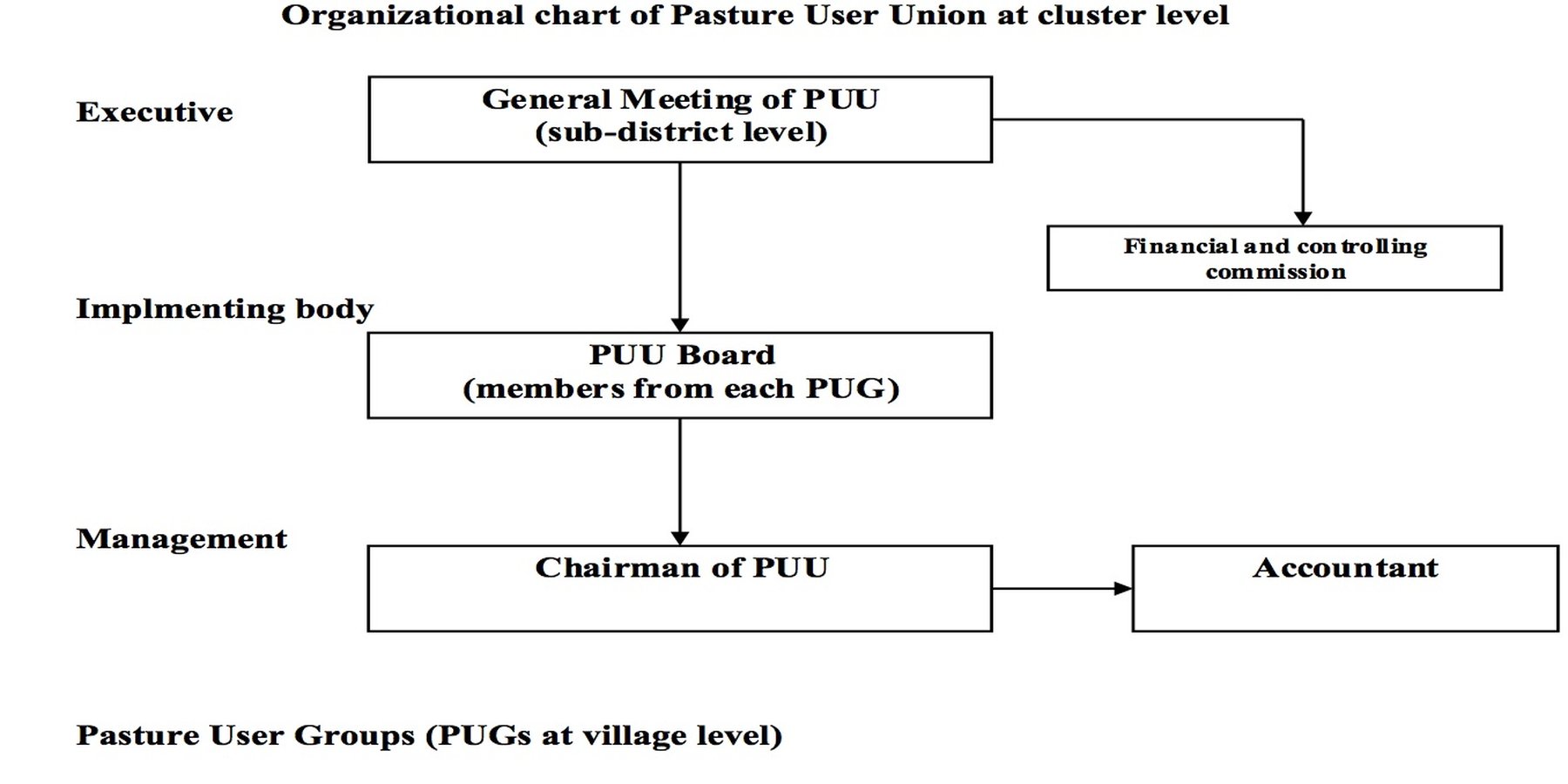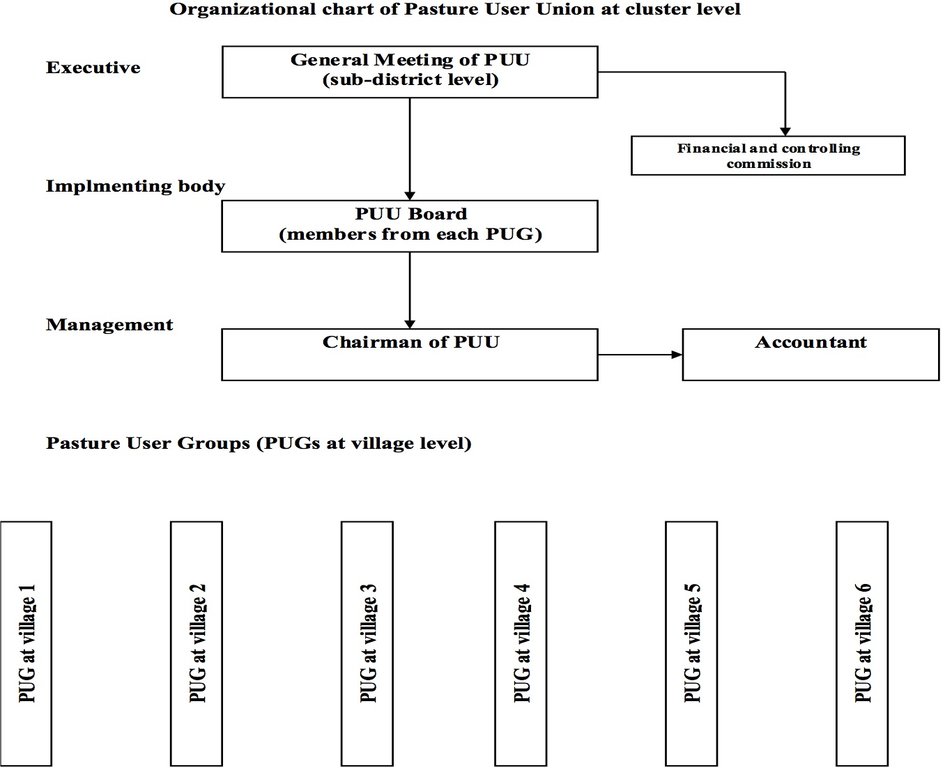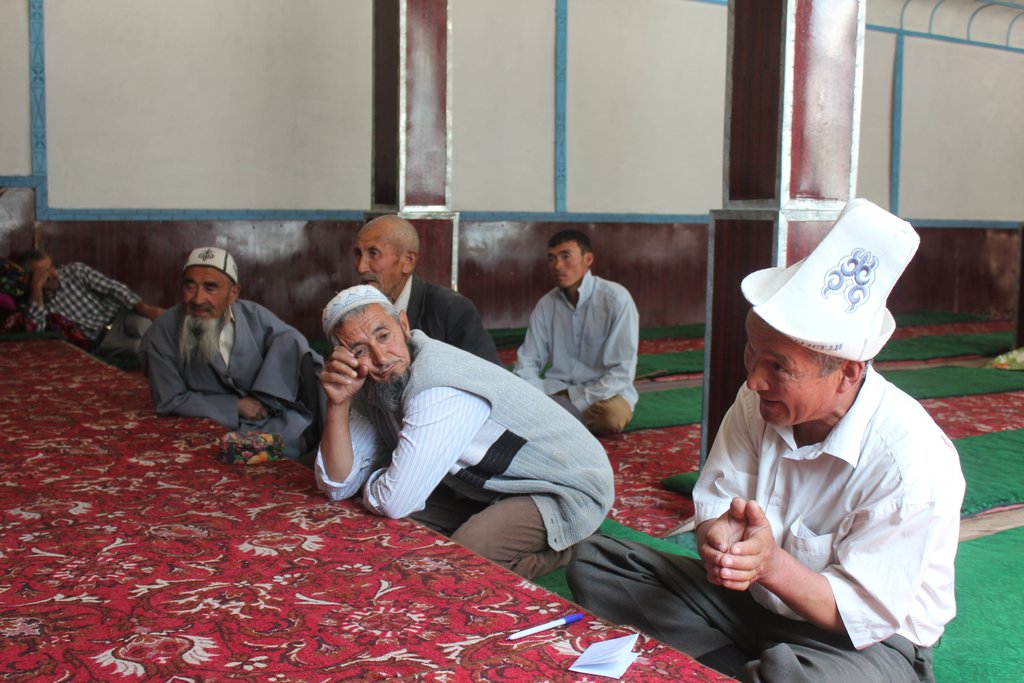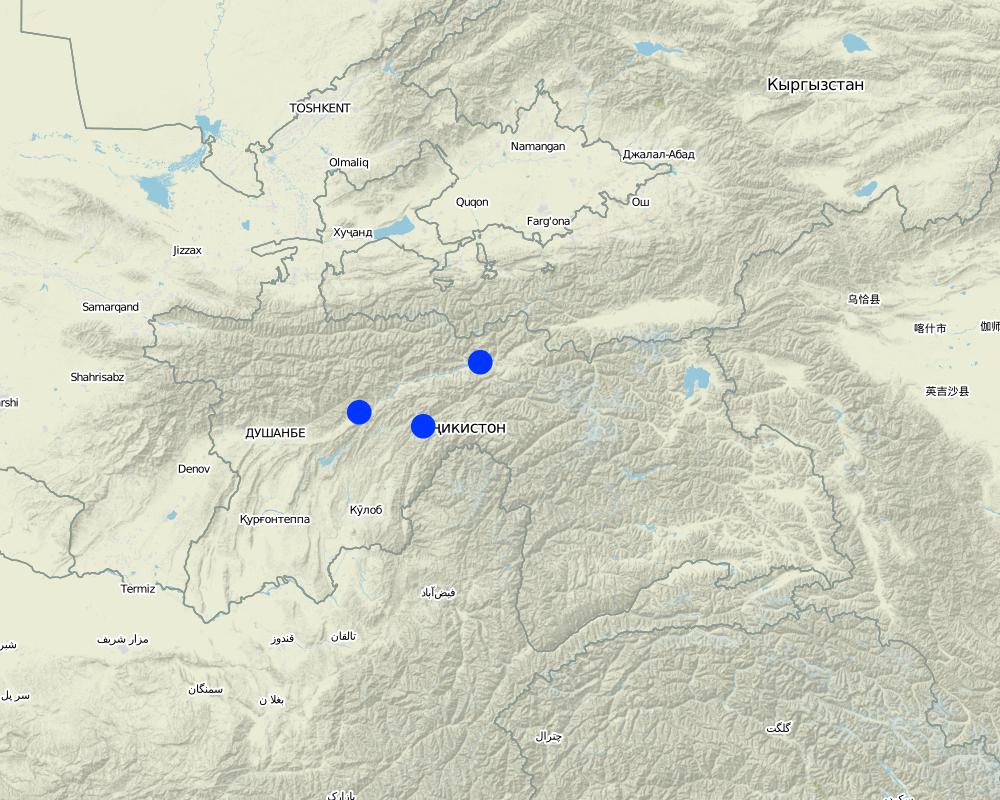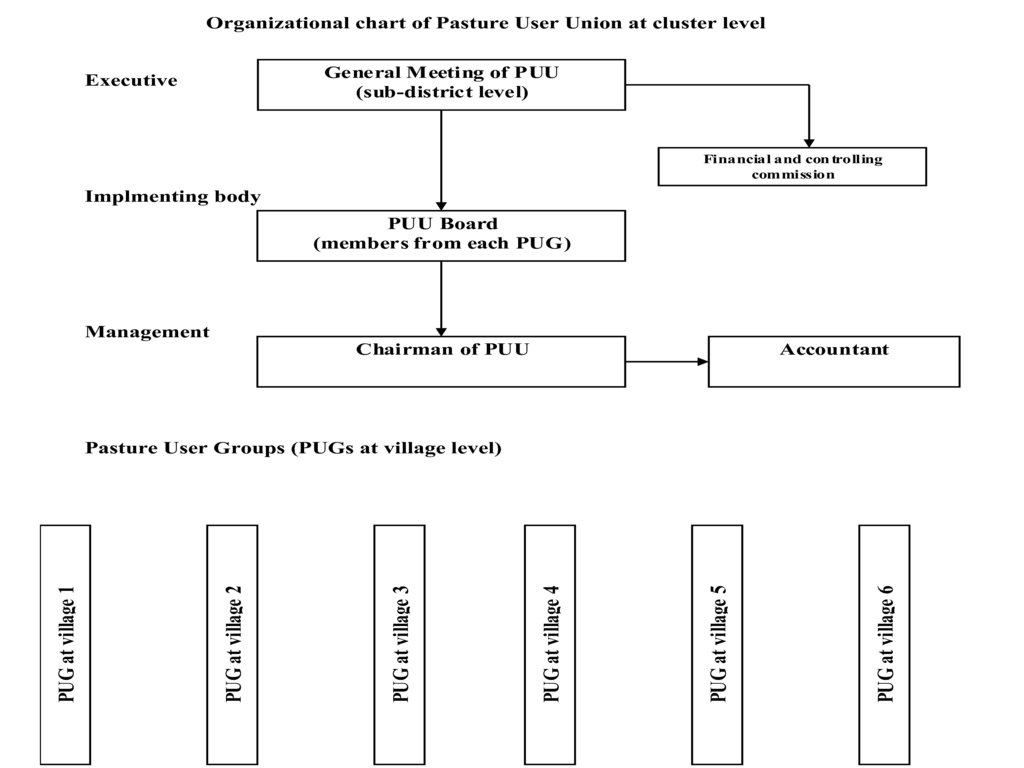Cluster Level Pasture User Union [Tajikistan]
- Creation:
- Update:
- Compiler: Askarsho Zevarshoev
- Editor: –
- Reviewers: Yacime Khadraoui, Maximilian Knoll
Чамъияти Чарогохистифодабарандагон дар сатхи кластер
approaches_3443 - Tajikistan
View sections
Expand all Collapse all1. General information
1.2 Contact details of resource persons and institutions involved in the assessment and documentation of the Approach
1.3 Conditions regarding the use of data documented through WOCAT
When were the data compiled (in the field)?
21/05/2014
The compiler and key resource person(s) accept the conditions regarding the use of data documented through WOCAT:
Ja
1.4 Reference(s) to Questionnaire(s) on SLM Technologies

Технология управлениия пастбищами в условиях Западного Памира [Tajikistan]
Управление пастбищных угодий путем внедрения новой техники пастбищеоборота с учетом емкости пастбища
- Compiler: Aslam Qadamov
2. Description of the SLM Approach
2.1 Short description of the Approach
Pasture User Unions (PUUs) at cluster level is consolidating several communities to jointly plan and implement pasture and livestock management related interventions. This approach is supporting to cover big area of pasture lands, which is used by several communities and do not have physical boundaries to define. Therefore joint planning of several communities at cluster level will help communities to meet the need of sustainable pasture and livestock management planning to improve their livelihoods.
2.2 Detailed description of the Approach
Detailed description of the Approach:
Pasture User Unions (PUUs) are legally recognized institutional structures under the Law on Pasture of the Republic of Tajikistan (Law of the Republic of Tajikistan on March 19, 2013, #951). Communities and individuals started the establishment of PUUs after the law passed on to organize themselves for better management of their pasture resources. Establishment of PUUs started with introducing development projects immediately after the law passed. The PUU approach had been tested at different levels starting from small units of pasture area, on village level and up to the sub-district level. Under ELMARL project for the purpose for the bigger environmental effects and coverage PUU was tested at cluster level, combining several community level pasture user groups (PUGs) with their representation at cluster level.
The main goal of this approach is to bring several communities under one legal structure for better management of pasture resources, which are interlinked in terms of physical boundaries and social aspects.
The project used participatory methods to bring several villages/communities under one umbrella in the framework of Governmental law on pastures. The planning process for the PUU starts with the first sector on stakeholder analysis, where the main actors are identified. The main stakeholders are community based organizations or village organizations, which also include livestock owners who become members of the PUU, land users of dehkan farms (peasant farms), which are the owners of the pasture/land resources, local governments and their related departments (e.g. land committee, agricultural department, environmental department).
Community based organizations/village organizations are community level structures, which come together to form their legal structure at higher levels for better management of pasture resources. Land/pasture users are the main actors which are responsible for day to day use of the pasture and implementation of technologies and local governments, that takes a leading role in distribution of land and facilitating the process of land use in the area. The majority of community members did like the approach when it was introduced and the purpose was explained, because it contributes to a more sustainable use of their resources. Only those livestock owners that own a big number of livestock are not willing to become part of the PUUs and to participate in the sustainable management of pasture resource. This is because they own big areas of pasture by themselves and are not interested to collaborate with the community.
2.3 Photos of the Approach
General remarks regarding photos:
Livestock owners came together to discuss the possibility of establishing their own community level structure under the Law on Pasture of the Republic of Tajikistan with project experts to explain them the new law and advantages of creating their own institute.
2.5 Country/ region/ locations where the Approach has been applied
Country:
Tajikistan
Region/ State/ Province:
Central Asia/Tajikistan/Rasht Valley
Further specification of location:
Faizobod, Roghun, Lakhsh and sub-ordinate districts
Comments:
Under ELMARL project cluster level PUUs had been established in four districts of Rasht Valley, which are Faizobod, Roghun, Tavildara and Lakhsh.
Map
×2.6 Dates of initiation and termination of the Approach
If precise year is not known, indicate approximate date when the Approach was initiated:
less than 10 years ago (recently)
Comments:
PUUs are still functional in this area.
2.7 Type of Approach
- recent local initiative/ innovative
2.8 Main aims/ objectives of the Approach
Support and empower legal structures with focus on pasture management and livestock development according to the Pasture Law of the Republic of Tajikistan.
2.9 Conditions enabling or hindering implementation of the Technology/ Technologies applied under the Approach
social/ cultural/ religious norms and values
- enabling
Traditionally communities are involved in the management of their pasture resources, previously based on traditional structure, therefore the proposed approach is socially and culturally applicable and well perceived by communities.
availability/ access to financial resources and services
- hindering
only project based, further depends on community and PUU leadership, how active they are
institutional setting
- enabling
The PUU is a legal structure according to the pasture law.
collaboration/ coordination of actors
- enabling
All partners and stakeholders are involved in managing the PUU.
legal framework (land tenure, land and water use rights)
- enabling
gives rights to the PUU to own the pasture lands
land governance (decision-making, implementation and enforcement)
- enabling
Once the land and pasture resources are owned by PUU they are legally enabled to make their own decisions on the use and management of the resources according to the existing laws and regulations.
knowledge about SLM, access to technical support
- enabling
helps communities and PUU to implement diverse technologies in management and improvement of the pasture lands
markets (to purchase inputs, sell products) and prices
- hindering
Marketing issues are not targeted.
workload, availability of manpower
- hindering
Because of the high volume of migration some of the management and leadership teams can migrate and hinder the availability of management. Youth is mainly in migration therefore hindering the availability of manpower.
3. Participation and roles of stakeholders involved
3.1 Stakeholders involved in the Approach and their roles
- local land users/ local communities
members of PUU and livestock owners
are the main actors of the PUU, responsible for overall management of the PUU and day to day activities' implementation with regards to pasture use. They also responsible for the implementation of the pasture plan which is developed jointly with the support of the project technical team.
- community-based organizations
village organization, common interest groups, village technology groups
are direct partners of the PUU, which also mobilize communities to join and participate in the pasture management
- SLM specialists/ agricultural advisers
project technical team
well mainly responsible in development of the pasture management plan methodology, capacity building of the pasture users/PUU members and ensure compliance of technical aspects of pasture management with PUU members
- NGO
locally registered Public Organization involved in environmental and natural resource management
in fundraising, introducing the PUU members with innovative technologies and approach
- local government
all departments at local level involved in the management of natural resources like agriculture, environmental protection, land departments, committee of emergency and other
collaborates with PUU and empowers the sector to specify topics and lobby their interests at the district level
- national government (planners, decision-makers)
Land Committee, Ministry of Agriculture, Committee on the Environmental protection
empower and lobby their interest at national level, guidance
- international organization
all existing in the country, including GIZ, Aga Khan Foundation, World Bank, European Commission, ACTED, Caritas etc.,
support with fund raising, provide guidance and exposure on best practices
3.2 Involvement of local land users/ local communities in the different phases of the Approach
| Involvement of local land users/ local communities | Specify who was involved and describe activities | |
|---|---|---|
| initiation/ motivation | external support | PUU members, livestock owners, mobilization of people to come together, support project team with collecting information, participate in the capacity building campaigns |
| planning | interactive | PUU members, livestock owners, active participation in the development of pasture and livestock management plan, participate in the session |
| implementation | self-mobilization | PUU members and other livestock owners. After the pasture and livestock management plan is approved PUU members with support of the PUU management structure were supported with funding and they have implemented different interventions, like fencing of pasture areas, support livestock owners with seeds to grow fodder, income generating activities like beekeeping. |
| monitoring/ evaluation | external support | The project team with support of the monitoring and evaluation specialist and technical staff conducted continuos support during the implementation phase. |
3.3 Flow chart (if available)
Description:
This is the organizational chart of the PUU, specifically those established at the cluster level with involvement of several communities. Members from each community are represented in the board and the board is selecting the management staff. The highest body as executive is the general meeting of the PUU, which consists of all members of the PUU.
Author:
Zevarshoev Askarsho
3.4 Decision-making on the selection of SLM Technology/ Technologies
Specify who decided on the selection of the Technology/ Technologies to be implemented:
- all relevant actors, as part of a participatory approach
Explain:
During the planning process all stakeholder participate and decide on which kind of action to implement, but separately pasture users are also actively implementing their traditional practices.
Specify on what basis decisions were made:
- evaluation of well-documented SLM knowledge (evidence-based decision-making)
4. Technical support, capacity building, and knowledge management
4.1 Capacity building/ training
Was training provided to land users/ other stakeholders?
Ja
Specify who was trained:
- land users
If relevant, specify gender, age, status, ethnicity, etc.
mixed, with special focus on equal participation of gender and balanced ages
Form of training:
- on-the-job
- demonstration areas
- public meetings
- courses
Subjects covered:
pasture management, accounting, proposal development, environmental land management
4.2 Advisory service
Do land users have access to an advisory service?
Ja
Specify whether advisory service is provided:
- on land users' fields
Describe/ comments:
During visits to the site by the project team consisting of specialists, advisory service was provided to the PUU members. The project also involved specialists from universities and livestock institute who conducted trainings and also provided advisory services.
4.3 Institution strengthening (organizational development)
Have institutions been established or strengthened through the Approach?
- yes, greatly
Specify the level(s) at which institutions have been strengthened or established:
- local
Describe institution, roles and responsibilities, members, etc.
Pasture User Union is a legal institute established at local level, which is mainly involved in the sustainable use and management of pastures and livestock. Almost all livestock owners in the targeted zone become members of the PUU to
Specify type of support:
- financial
- capacity building/ training
- equipment
Give further details:
All three type of support were provided to the institute, starting from the establishment up to the development of their plan and implementation of this plan.
4.4 Monitoring and evaluation
Is monitoring and evaluation part of the Approach?
Ja
Comments:
Continous monitoring of the project was made by the project team to ensure effective implementation of planned activities.
If yes, is this documentation intended to be used for monitoring and evaluation?
Ja
4.5 Research
Was research part of the Approach?
Nee
5. Financing and external material support
5.1 Annual budget for the SLM component of the Approach
If precise annual budget is not known, indicate range:
- 2,000-10,000
Comments (e.g. main sources of funding/ major donors):
Environmental Land Management and Rural Livelihood Project, implemented by the Committee on Environmental Protection of the Republic of Tajikistan
5.2 Financial/ material support provided to land users
Did land users receive financial/ material support for implementing the Technology/ Technologies?
Ja
If yes, specify type(s) of support, conditions, and provider(s):
funding support to facilitate communities to establish their PUU and registration fee under the Law of the Republic of Tajikistan on Pasture Management
5.3 Subsidies for specific inputs (including labour)
- equipment
| Specify which inputs were subsidised | To which extent | Specify subsidies |
|---|---|---|
| machinery | fully financed | machinery, like tractors, was provided to the PUU for development of their pasture infrastrucutre |
| tools | partly financed | funding for other interventions like establishment of veterinarian drug store, improvement of pasture etc. |
- construction
| Specify which inputs were subsidised | To which extent | Specify subsidies |
|---|---|---|
| wood | partly financed | funding for procurement of wood for construction of animal shed in the remote pasture |
- infrastructure
| Specify which inputs were subsidised | To which extent | Specify subsidies |
|---|---|---|
| roads | partly financed | cost to rent bulldozer, cost for fuel for the machinery to clean and rehabilitate the road |
If labour by land users was a substantial input, was it:
- voluntary
5.4 Credit
Was credit provided under the Approach for SLM activities?
Nee
5.5 Other incentives or instruments
Were other incentives or instruments used to promote implementation of SLM Technologies?
Ja
If yes, specify:
Specialized training was provided for the PUU members on the new Pasture Law and community participation in the round table discussion on revision and providing feedback to improvement of pasture law organized by the Pasture Network Secretariat.
6. Impact analysis and concluding statements
6.1 Impacts of the Approach
Did the Approach empower local land users, improve stakeholder participation?
- No
- Yes, little
- Yes, moderately
- Yes, greatly
First the approach was brought together under one structure to discuss the common issues, which relates to all involved stakeholder. Land users become the owner of legal structure under the law of the government, which empowered them to lobby their interest at the governmental level.
Did the Approach enable evidence-based decision-making?
- No
- Yes, little
- Yes, moderately
- Yes, greatly
during the process of pasture and livestock management plan development in a participatory manner, where youth and women have also participated
Did the Approach help land users to implement and maintain SLM Technologies?
- No
- Yes, little
- Yes, moderately
- Yes, greatly
The approach lead to the development of the pasture and livestock management plan with a specific action plan for implementation. The implementation plan involves different technologies and approach to test and learn for dissemination and replication to other areas.
Did the Approach improve coordination and cost-effective implementation of SLM?
- No
- Yes, little
- Yes, moderately
- Yes, greatly
Since the approach brought together several communities at cluster level to manage their pasture resources, it required a lot of effort to coordinate the activities among each other in consultation with experts.
Did the Approach mobilize/ improve access to financial resources for SLM implementation?
- No
- Yes, little
- Yes, moderately
- Yes, greatly
As a legal structure the PUU is eligible to apply for any available funding.
Did the Approach improve knowledge and capacities of land users to implement SLM?
- No
- Yes, little
- Yes, moderately
- Yes, greatly
After establishment of the PUU, a series of trainings and sharing of experiences were provided to the members to learn from best practices and test them in their area.
Did the Approach improve knowledge and capacities of other stakeholders?
- No
- Yes, little
- Yes, moderately
- Yes, greatly
Through establishment the PUUs their management as an institute conducted meeting with other involved stakeholders and explained them their structure. Other identified stakeholders, like land users from neighbor communities were also invited to the capacity building sessions and trainings.
Did the Approach build/ strengthen institutions, collaboration between stakeholders?
- No
- Yes, little
- Yes, moderately
- Yes, greatly
In the action plan of the PUU roles and responsibilities of direct involved stakeholders were defined and their roles to interact with other relevant institutions identified. The approach of participatory planning took all stakeholders interests into consideration.
Did the Approach mitigate conflicts?
- No
- Yes, little
- Yes, moderately
- Yes, greatly
Several communities came together with all stakeholders to talk on the existing challenges and mitigate the possible conflict arising from the use of pasture resources.
Did the Approach improve gender equality and empower women and girls?
- No
- Yes, little
- Yes, moderately
- Yes, greatly
Women's roles in the management of livestock and pasture management were identified and taken into consideration to involve them in the decision making process.
Did the Approach improve issues of land tenure/ user rights that hindered implementation of SLM Technologies?
- No
- Yes, little
- Yes, moderately
- Yes, greatly
PUU enabled the members to own certain amount of pasture land and have to go through certain procedures to improve the ownership over their land.
Did the Approach improve the capacity of the land users to adapt to climate changes/ extremes and mitigate climate related disasters?
- No
- Yes, little
- Yes, moderately
- Yes, greatly
PUU enabled land users and its members to get introduced to the best practices on improvment of pasture management, which also helps them to mitigate the climate change and prevention of possible disasters like landslide and mudflow which is common as a result of pasture degradation
Did the Approach lead to employment, income opportunities?
- No
- Yes, little
- Yes, moderately
- Yes, greatly
With establishment of PUU three people already became official employees of the institute and other got income through implementation of intervention. Once the pasture condition improves, the livestock productivity will also improve and will increase income.
6.2 Main motivation of land users to implement SLM
- increased production
increase pasture productivity and livestock products
- reduced land degradation
PUU to contribute to improve ownership over land resource and prevent overgrazing in the realm of degradation protection
- reduced risk of disasters
Pasture degradation usually is mainly caused by land slides and mudflows in this area. Once the condition of pastures is improved, it will also prevent natural hazards.
- environmental consciousness
As the project mainly focuses on environmental land management the approach considers also improvement of pasture condition to contribute to environmental protection.
6.3 Sustainability of Approach activities
Can the land users sustain what has been implemented through the Approach (without external support)?
- yes
If yes, describe how:
The PUU is a legal structure according to the law of the country and empowers the communities to become owner of their pasture resources. Through coordination from the local government there is continuous supervision on the performance of the structure, which contribute to its sustainability.
6.4 Strengths/ advantages of the Approach
| Strengths/ advantages/ opportunities in the land user’s view |
|---|
| can participate in the decision making, the communities own the resources, have their own structure |
| better opportunities for getting access to financial resources |
| Strengths/ advantages/ opportunities in the compiler’s or other key resource person’s view |
|---|
| owned by communities, legally registered according to the official law on pasture of the country |
| as a legal and community based structure recognized taking into consideration of all stakeholders and involves women and youth into decision making |
6.5 Weaknesses/ disadvantages of the Approach and ways of overcoming them
| Weaknesses/ disadvantages/ risks in the compiler’s or other key resource person’s view | How can they be overcome? |
|---|---|
| Comparing to other PUUs established only at one community level it is a more complicated structure and difficult to manage. | empower the community and the PUU leadership in management and leadership skills, more capacity building campaigns |
| Pasture resources owned by separate dekhkan farms, which are also legal structure according to the law | More facilitation processes should be applied to support and empower the PUU to become the full and only owners of the pasture resource. |
7. References and links
7.1 Methods/ sources of information
- interviews with SLM specialists/ experts
through direct interviews with the Implementing Agency technical experts and field facilitators
- compilation from reports and other existing documentation
1
7.3 Links to relevant information which is available online
Title/ description:
Pasture Management Networking Platform (PMNP)
URL:
https://pasture.klink.asia/dms/documents/groups/796?page=2
Links and modules
Expand all Collapse allLinks

Технология управлениия пастбищами в условиях Западного Памира [Tajikistan]
Управление пастбищных угодий путем внедрения новой техники пастбищеоборота с учетом емкости пастбища
- Compiler: Aslam Qadamov
Modules
No modules


